A Multi-Temporal Knowledge Graph Framework for Landslide Monitoring and Hazard Assessment
Abstract
1. Introduction
2. Materials and Methods
2.1. Dataset
2.2. Temporal Ontology for Landslide
2.3. Workflow
3. Results
3.1. Landslide Temporal Ontology Model
3.2. Temporal Knowledge Graph of Landslide
3.2.1. RDF-Based Construction of Temporal Knowledge Graph
3.2.2. Quadruples-Based Construction of Temporal Knowledge Graph
3.3. Query Experiment of the MTKG
3.3.1. Query Results from the RDF-Based Knowledge Graph
3.3.2. Query Results from the Quadruple-Based Knowledge Graph
3.4. Web Interface for MTKG Querying
4. Discussion
4.1. Core Innovations and Practical Value of MTKG
4.2. Technical Implementation and Effectiveness of Dynamic Queries
4.3. Current Challenges and Further Works
5. Conclusions
- (1)
- Construction: The MTKG effectively formalizes dynamic landslide knowledge through RDF-based version control and multi-time series quadruples (subject–predicate–object–timestamp), capturing updates such as elevation revisions and refinements to geological age.
- (2)
- Application: Through multi-dimensional queries implemented via SPARQL and Cypher, MTKGs support the extraction of dynamic knowledge from multiple dimensions, including time, entity attributes, and events.
- (1)
- Extending the MTKG into a spatiotemporal KG by embedding spatial attributes (e.g., crack network geometries) to model coupled time–space landslide behaviors.
- (2)
- Developing multi-time series embedding techniques to enhance dynamic reasoning across heterogeneous temporal resolutions (hourly, daily, and event-based).
- (3)
- Coupling the MTKG with machine learning models to enable predictive analytics (e.g., forecasting displacement thresholds based on historical time series trends).
Author Contributions
Funding
Data Availability Statement
Conflicts of Interest
Abbreviations
| RDF | Resource Description Framework |
| KG | Knowledge Graph |
| MTKG | Multi-Temporal Knowledge Graph |
References
- Chen, L.; Ge, X.; Yang, L.; Li, W.; Peng, L. An Improved Multi-Source Data-Driven Landslide Prediction Method Based on Spatio-Temporal Knowledge Graph. Remote Sens. 2023, 15, 2126. [Google Scholar] [CrossRef]
- Li, Y.; Wang, D.; Ma, Z.; Fan, Y.; Yang, B.; Liu, L.; Luo, C. Multi-source remote sensing landslide hazard identification method driven by knowledge graph. Bull. Surv. Mapp. 2024, 1, 12–18, (In Chinese with English Abstract). [Google Scholar] [CrossRef]
- Xu, Q.; Cui, S.; Huang, W.; Pei, X.; Fan, X.; Ai, Y.; Zhao, W.; Luo, Y.; Luo, J.; Liu, M.; et al. Construction of a Landslide Knowledge Graph in the Field of Engineering Geology. Geomat. Inf. Sci. Wuhan Univ. 2023, 48, 1601–1615, (In Chinese with English Abstract). [Google Scholar]
- Zhu, Q.; Zeng, H.W.; Ding, Y.L.; Xie, X.; Liu, F.; Zhang, L.G.; Li, H.F.; Hu, H.; Zhang, J.X.; Chen, L.; et al. Review of Analysis Methods for Major Landslide Hazards. Acta Geod. Cartogr. Sin. 2019, 48, 1551–1561. [Google Scholar]
- Hogan, A.; Blomqvist, E.; Cochez, M.; D’amato, C.; Melo, G.D.; Gutierrez, C.; Kirrane, S.; Gayo, J.E.L.; Navigli, R.; Neu-maier, S.; et al. Knowledge Graphs. ACM Comput. Surv. 2021, 54, 71. [Google Scholar] [CrossRef]
- Ma, X. Knowledge Graph Construction and Application in Geosciences: A Review. Comput. Geosci. 2022, 161, 105082. [Google Scholar] [CrossRef]
- Wang, C.; Li, Y.; Chen, J.; Ma, X. Named Entity Annotation Schema for Geological Literature Mining in the Domain of Porphyry Copper Deposits. Ore Geol. Rev. 2023, 152, 105243. [Google Scholar] [CrossRef]
- Harnoune, A.; Rhanoui, M.; Mikram, M.; Yousfi, S.; Elkaimbillah, Z.; El Asri, B. BERT Based Clinical Knowledge Extraction for Biomedical Knowledge Graph Construction and Analysis. Comput. Methods Programs Biomed. Update 2021, 1, 100042. [Google Scholar] [CrossRef]
- Luan, Y.; He, L.; Ostendorf, M. Multi-Task Identification of Entities, Relations, and Coreference for Scientific Knowledge Graph Construction. arXiv 2018, arXiv:1808.09602. [Google Scholar] [CrossRef]
- Wang, C.; Ma, X.; Chen, J.; Chen, J. Information Extraction and Knowledge Graph Construction from Geoscience Literature. Comput. Geosci. 2018, 112, 112–120. [Google Scholar] [CrossRef]
- Jin, Y.; von Seelen, W.; Sendhoff, B. An Approach to Rule-Based Knowledge Extraction. In Proceedings of the 1998 IEEE International Conference on Fuzzy Systems Proceedings, Anchorage, AK, USA, 4–9 May 1998; IEEE: Piscataway, NJ, USA, 1998; Volume 2, pp. 1188–1193. [Google Scholar]
- Sobhana, N.V.; Mitra, P.; Ghosh, S.K. Conditional Random Field Based Named Entity Recognition in Geological Text. Int. J. Comput. Appl. 2010, 1, 143–147. [Google Scholar] [CrossRef]
- Qiu, Q.; Xie, Z.; Wu, L.; Tao, L.; Li, W. BiLSTM-CRF for Geological Named Entity Recognition from Geoscience Literature. Earth Sci. Inform. 2019, 12, 565–579. [Google Scholar] [CrossRef]
- Wu, R.; Zhu, M.; Fu, X.; Mei, H.; Li, Z.; Zhang, L.; Wang, H.; Tu, Q. Construction of Geological Hazard Trend Prediction Model and Early Warning System in Three Gorges Reservoir Area. South China Geol. 2023, 39, 455–469, (In Chinese with English Abstract). [Google Scholar]
- Wang, B.; Wu, L.; Xie, Z.; Qiu, Q.; Zhou, Y.; Ma, K.; Tao, L. Understanding Geological Reports Based on Knowledge Graphs Using a Deep Learning Approach. Comput. Geosci. 2022, 168, 105229. [Google Scholar] [CrossRef]
- Fan, R.; Wang, L.; Yan, J.; Song, W.; Zhu, Y.; Chen, X. Deep Learning-Based Named Entity Recognition and Knowledge Graph Construction for Geological Hazards. ISPRS Int. J. Geo-Inf. 2020, 9, 15. [Google Scholar] [CrossRef]
- Dagdelen, J.; Dunn, A.; Lee, S.; Walker, N.; Rosen, A.S.; Ceder, G.; Persson, K.A.; Jain, A. Structured Information Extraction from Scientific Text with Large Language Models. Nat. Commun. 2024, 15, 1418. [Google Scholar] [CrossRef]
- Zhang, Y.; Zhu, J.; Zhu, Q.; Xie, Y.; Li, W.; Fu, L.; Zhang, J.; Tan, J. The Construction of Personalized Virtual Landslide Dis-aster Environments Based on Knowledge Graphs and Deep Neural Networks. Int. J. Digit. Earth 2020, 13, 1637–1655. [Google Scholar] [CrossRef]
- Ge, X.; Yang, Y.; Chen, J.; Li, W.; Huang, Z.; Zhang, W.; Peng, L. Disaster Prediction Knowledge Graph Based on Multi-Source Spatio-Temporal Information. Remote Sens. 2022, 14, 1214. [Google Scholar] [CrossRef]
- Ma, L.; Wang, J.; Cheng, J.; Wang, X.; Zhu, W. MLRP-KG: Mine Landslide Risk Prediction Based on Knowledge Graph. IEEE Trans. Artif. Intell. 2022, 3, 78–87. [Google Scholar] [CrossRef]
- Wu, Q.; Xie, Z.; Tian, M.; Qiu, Q.; Chen, J.; Tao, L.; Zhao, Y. Integrating Knowledge Graph and Machine Learning Methods for Landslide Susceptibility Assessment. Remote Sens. 2024, 16, 2399. [Google Scholar] [CrossRef]
- Liu, H.; Ding, Q.; Yang, X. A Knowledge-Guided Approach for Landslide Susceptibility Mapping Using Convolutional Neural Net-work and Graph Contrastive Learning. Sustainability 2024, 16, 4547. [Google Scholar] [CrossRef]
- Zhang, Y.; Zhang, J.; Dong, L. Fuzzy Logic Regional Landslide Susceptibility Multi-Field Information Map Representation Analysis Method Constrained by Spatial Characteristics of Mining Factors in Mining Areas. Processes 2023, 11, 985. [Google Scholar] [CrossRef]
- Xu, Q.; Tang, M.G.; Xu, K.X.; Huang, X.B. Study on the Temporal and Spatial Evolution Law and Early Warning and Forecast of Landslides. Chin. J. Rock Mech. Eng. 2008, 27, 1104–1112, (In Chinese with English Abstract). [Google Scholar]
- Samia, J.; Temme, A.; Bregt, A.; Wallinga, J.; Guzzetti, F.; Ardizzone, F.; Rossi, M. Do Landslides Follow Landslides? In-sights in Path Dependency from a Multi-Temporal Landslide Inventory. Landslides 2017, 14, 547–558. [Google Scholar] [CrossRef]
- Ma, M.; Wang, J.L.; Chen, Q.; Li, J. Regional Landslide Susceptibility Evaluation Based on Information Value Weighted by Random Forest: A Case Study from Zigui to Badong Section in the Three Gorges Reservoir Area. South China Geol. 2024, 40, 749–763, (In Chinese with English Abstract). [Google Scholar]
- Zhou, C.; Yin, K.; Cao, Y.; Ahmed, B.; Li, Y.; Catani, F.; Pourghasemi, H.R. Landslide Susceptibility Modeling Applying Machine Learning Methods: A Case Study from Longju in the Three Gorges Reservoir Area, China. Comput. Geosci. 2018, 112, 23–37. [Google Scholar] [CrossRef]
- Li, M.; Jiang, W.J.; Dong, J.H.; Jin, S.; Zhang, C.; Niu, R. Landslide Disaster Susceptibility Evaluation Based on Machine Learning: A Case Study of the Three Gorges Reservoir Area. South China Geol. 2023, 39, 413–427, (In Chinese with English Abstract). [Google Scholar]
- Yang, S.S.; Ye, R.Q.; Fu, X.L.; Wu, R.; Xiong, N.; Wen, T. Research on the Warning Rainfall Threshold of Rainfall–Induced Landslides in the Three Gorges Reservoir Area. South China Geol. 2023, 39, 445–454, (In Chinese with English Abstract). [Google Scholar]
- Tang, X.; Feng, Z.; Xiao, Y.; Wang, M.; Ye, T.; Zhou, Y.; Meng, J.; Zhang, B.; Zhang, D. Construction and Application of an Ontology-Based Domain-Specific Knowledge Graph for Petroleum Exploration and Development. Geosci. Front. 2023, 14, 101426. [Google Scholar] [CrossRef]
- Lacroix, T.; Obozinski, G.; Usunier, N. Tensor Decompositions for Temporal Knowledge Base Completion. arXiv 2020, arXiv:2004.04926. [Google Scholar] [CrossRef]
- Zhou, C.; Wang, H.; Wang, C.; Hou, Z.; Zheng, Z.; Shen, S.; Cheng, Q.; Feng, Z.; Wang, X.; Lv, H.; et al. Geoscience Knowledge Graph in the Big Data Era. Sci. China Earth Sci. 2021, 64, 1105–1114. [Google Scholar] [CrossRef]
- Yang, B.; Yin, K.; Lacasse, S.; Liu, Z. Time Series Analysis and Long Short-Term Memory Neural Network to Predict Land-slide Displacement. Landslides 2019, 16, 677–694. [Google Scholar] [CrossRef]
- Ebrahim, K.M.P.; Fares, A.; Faris, N.; Zayed, T. Exploring Time Series Models for Landslide Prediction: A Literature Review. Geoenviron. Disasters 2024, 11, 25. [Google Scholar] [CrossRef]
- Lombardo, L.; Opitz, T.; Ardizzone, F.; Guzzetti, F.; Huser, R. Space-Time Landslide Predictive Modelling. Earth-Sci. Rev. 2020, 209, 103318. [Google Scholar] [CrossRef]
- Shi, P.J. Theory and practice on disaster system research in a fourth time. J. Nat. Disasters 2005, 18, 1–9. [Google Scholar]
- RobatJazi, M.; Reformat, M.Z.; Pedrycz, W.; Musilek, P. Querying RDF Data with Imprecise Time Phrases. In Proceedings of the 2015 IEEE/WIC/ACM International Conference on Web Intelligence and Intelligent Agent Technology (WI-IAT), Singapore, 6–9 December 2015; IEEE: Singapore, Singapore, 2015; pp. 445–450. [Google Scholar]
- Crozier, M.J. Deciphering the effect of climate change on landslide activity: A review. Geomorphology 2010, 124, 260–267. [Google Scholar] [CrossRef]

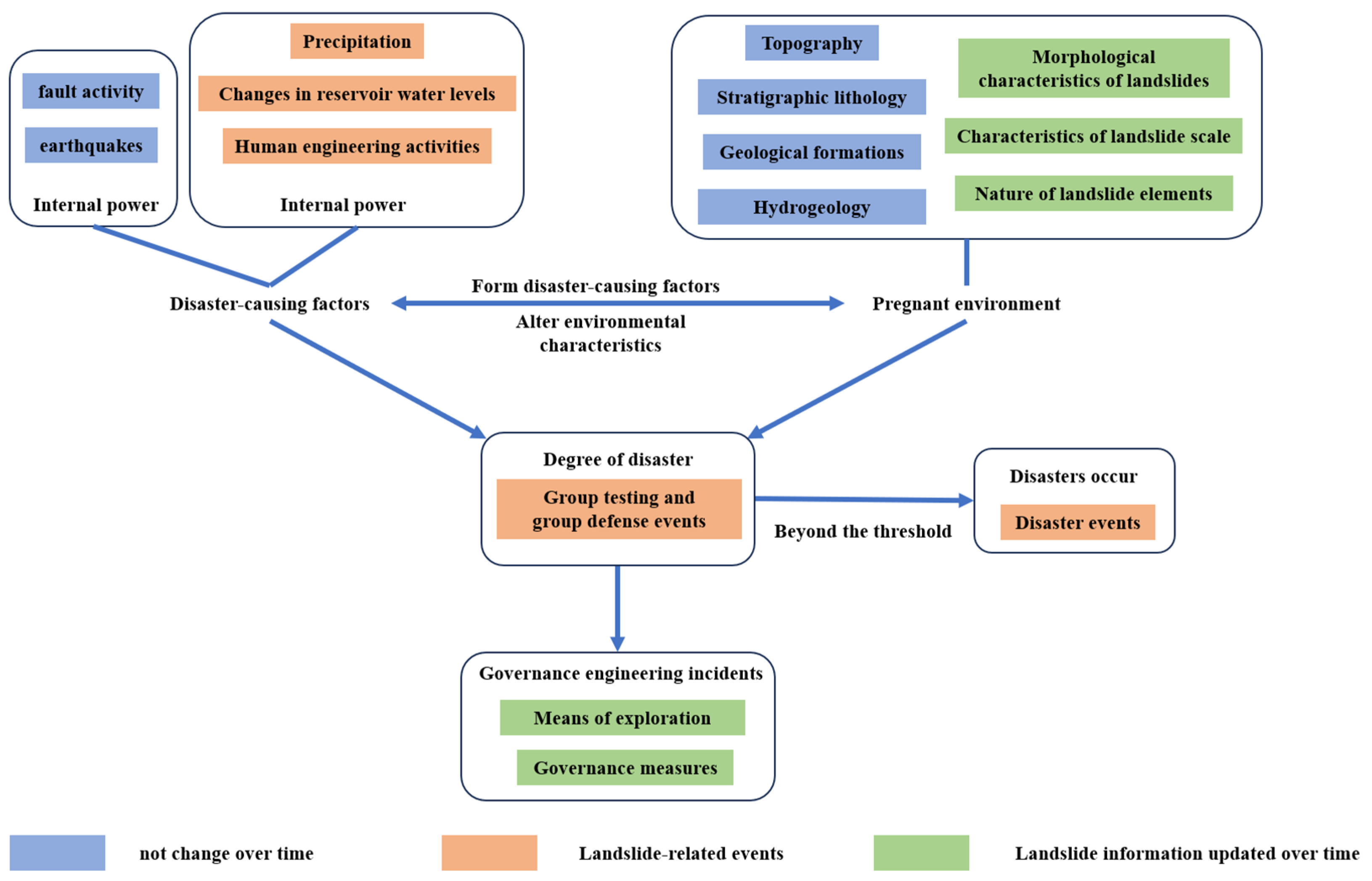
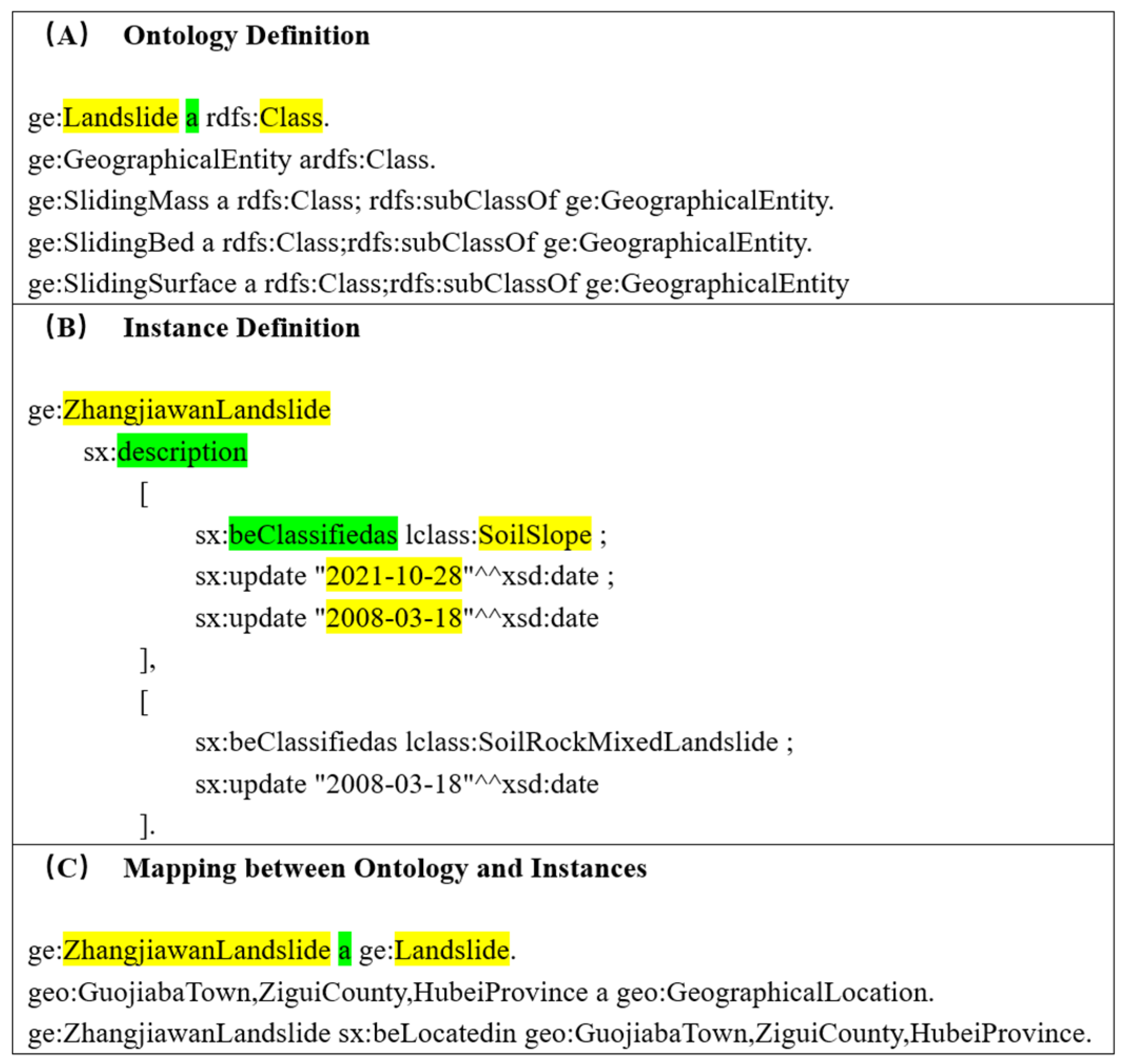
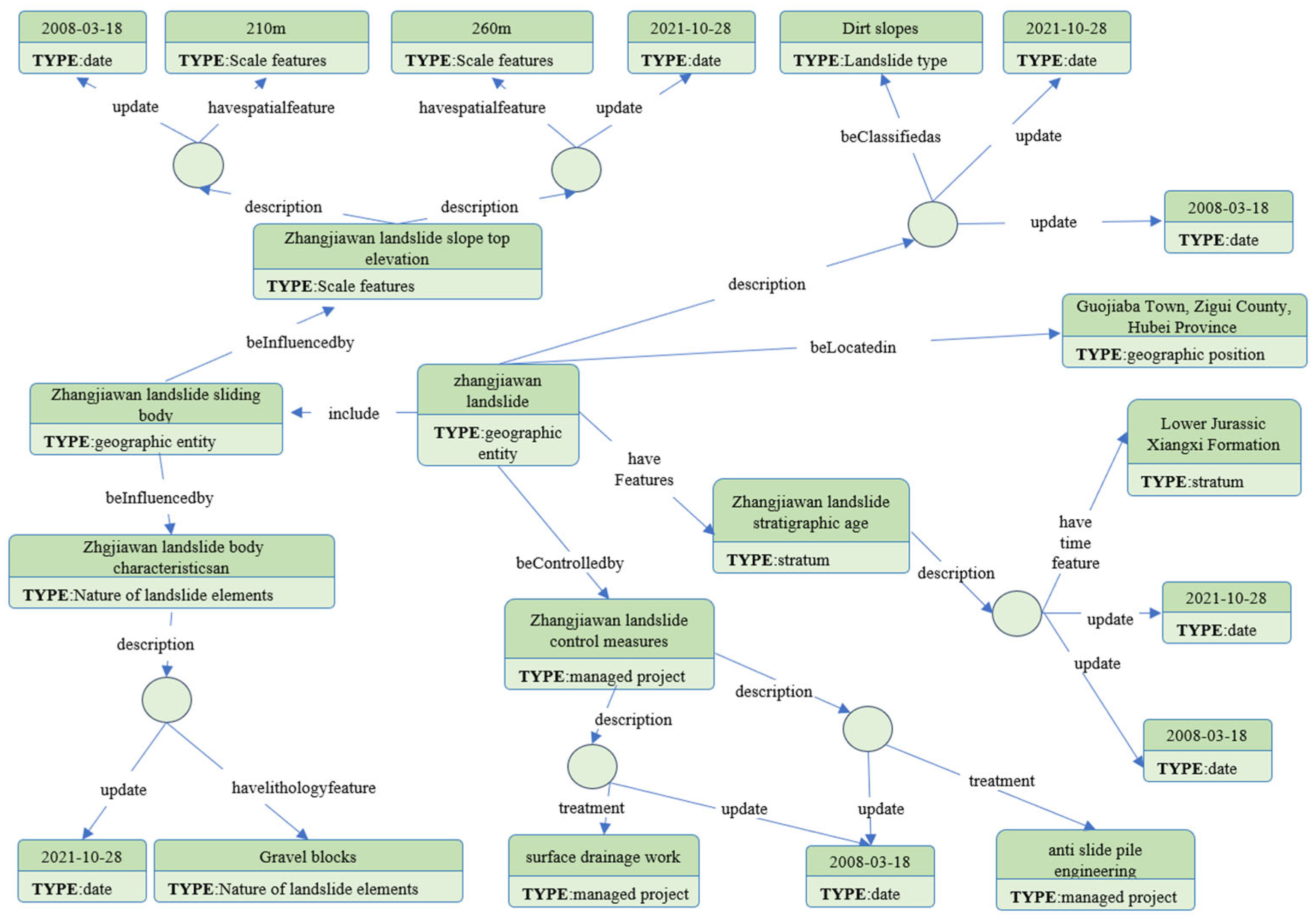
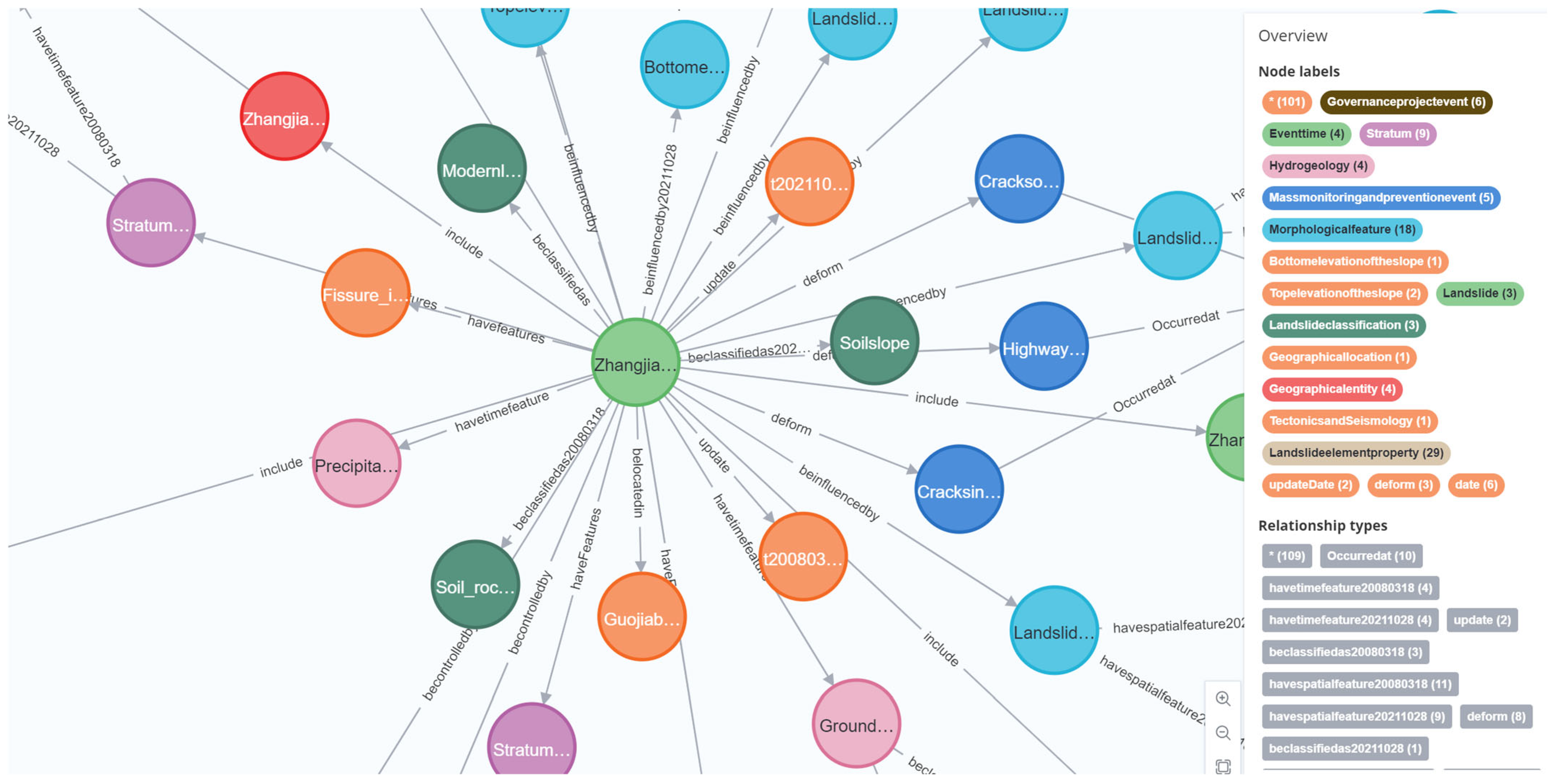

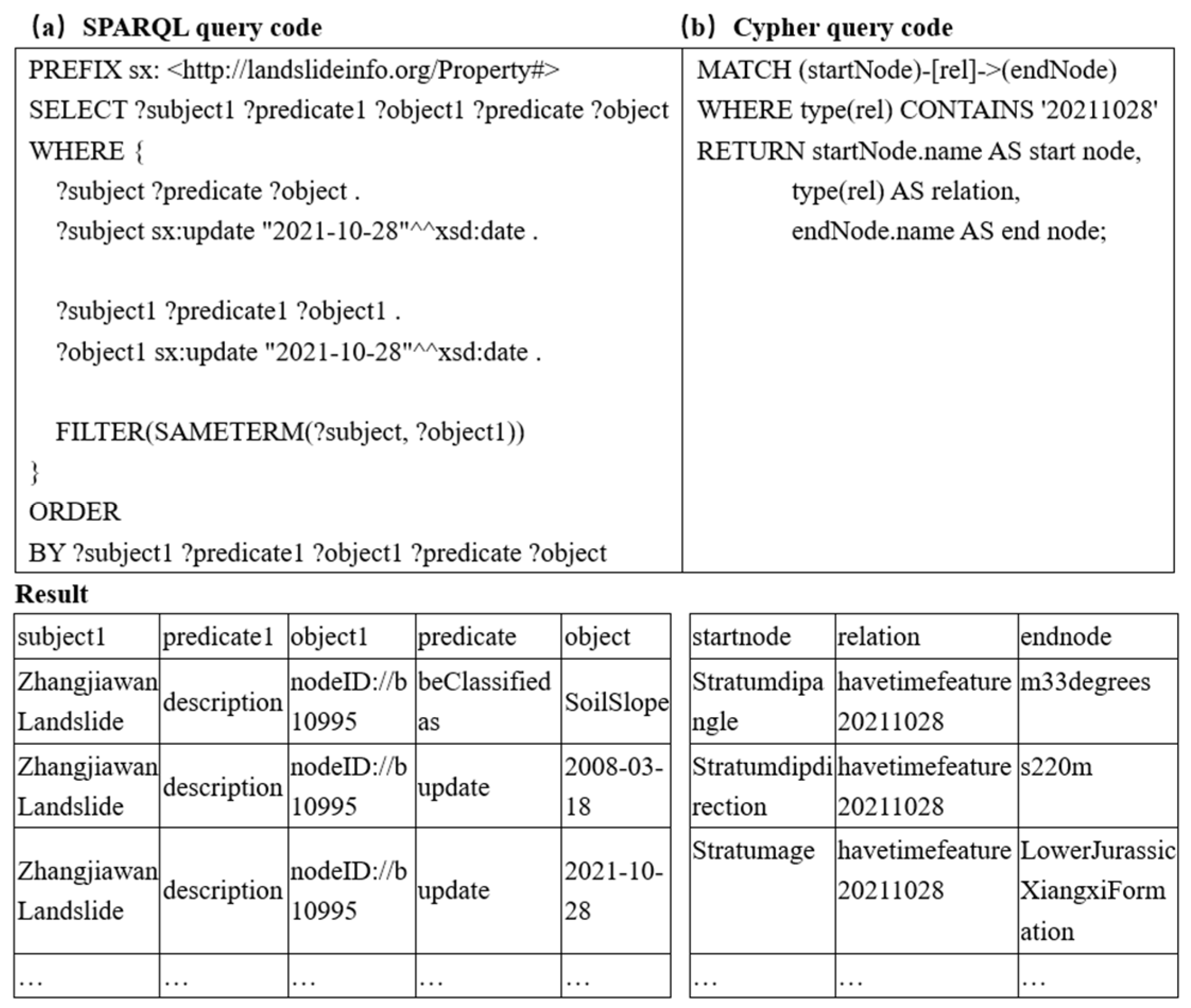
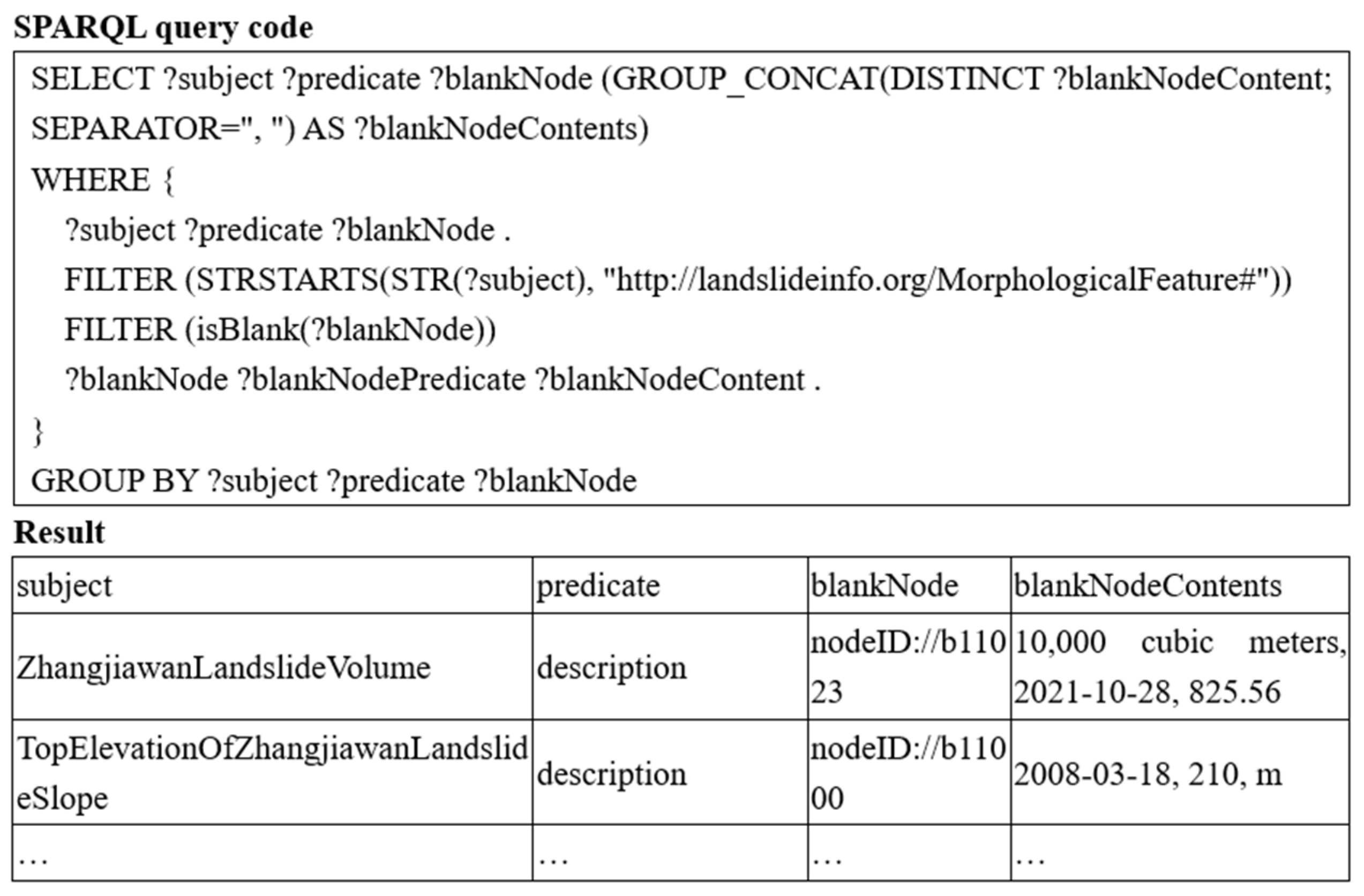
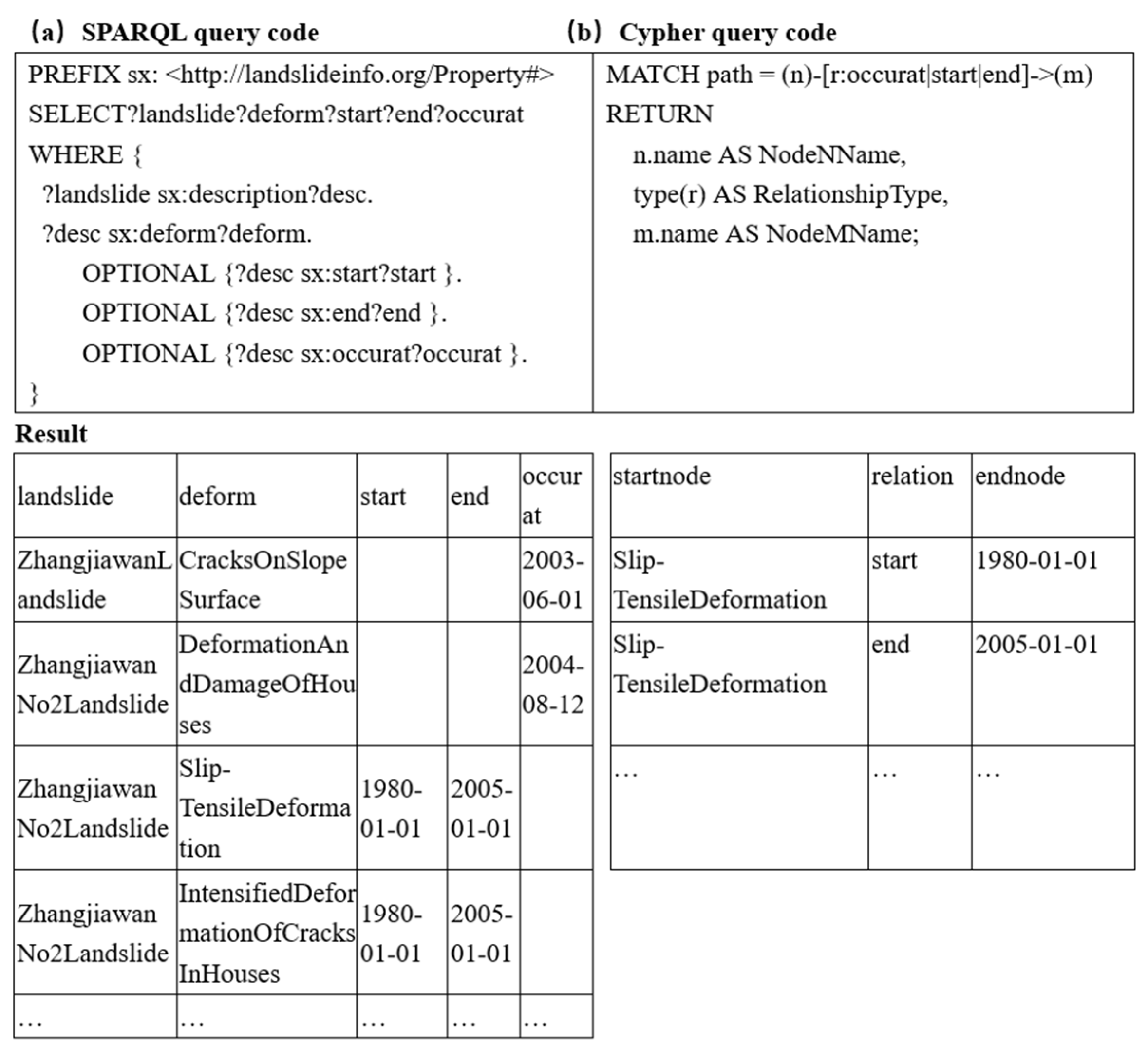
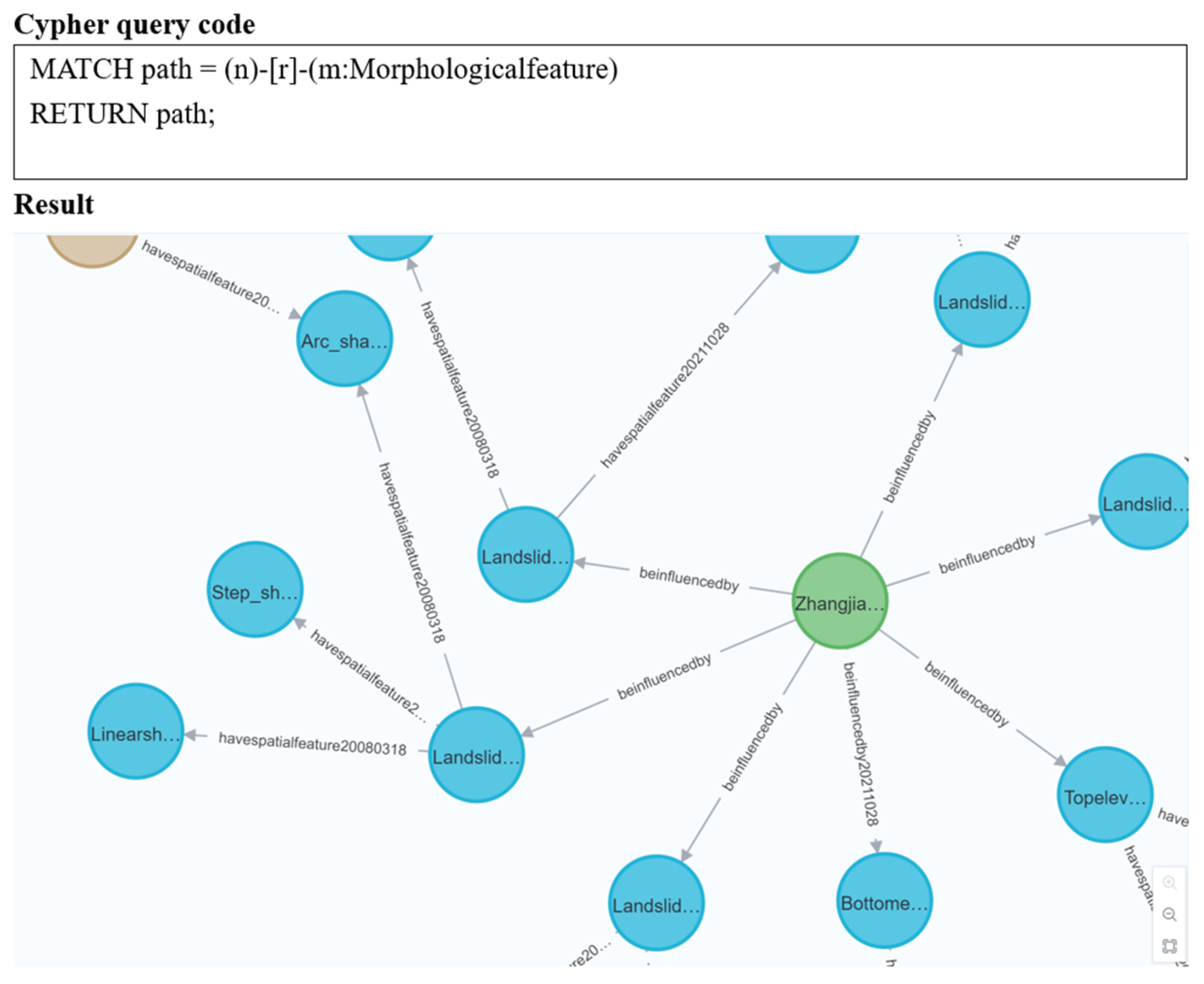
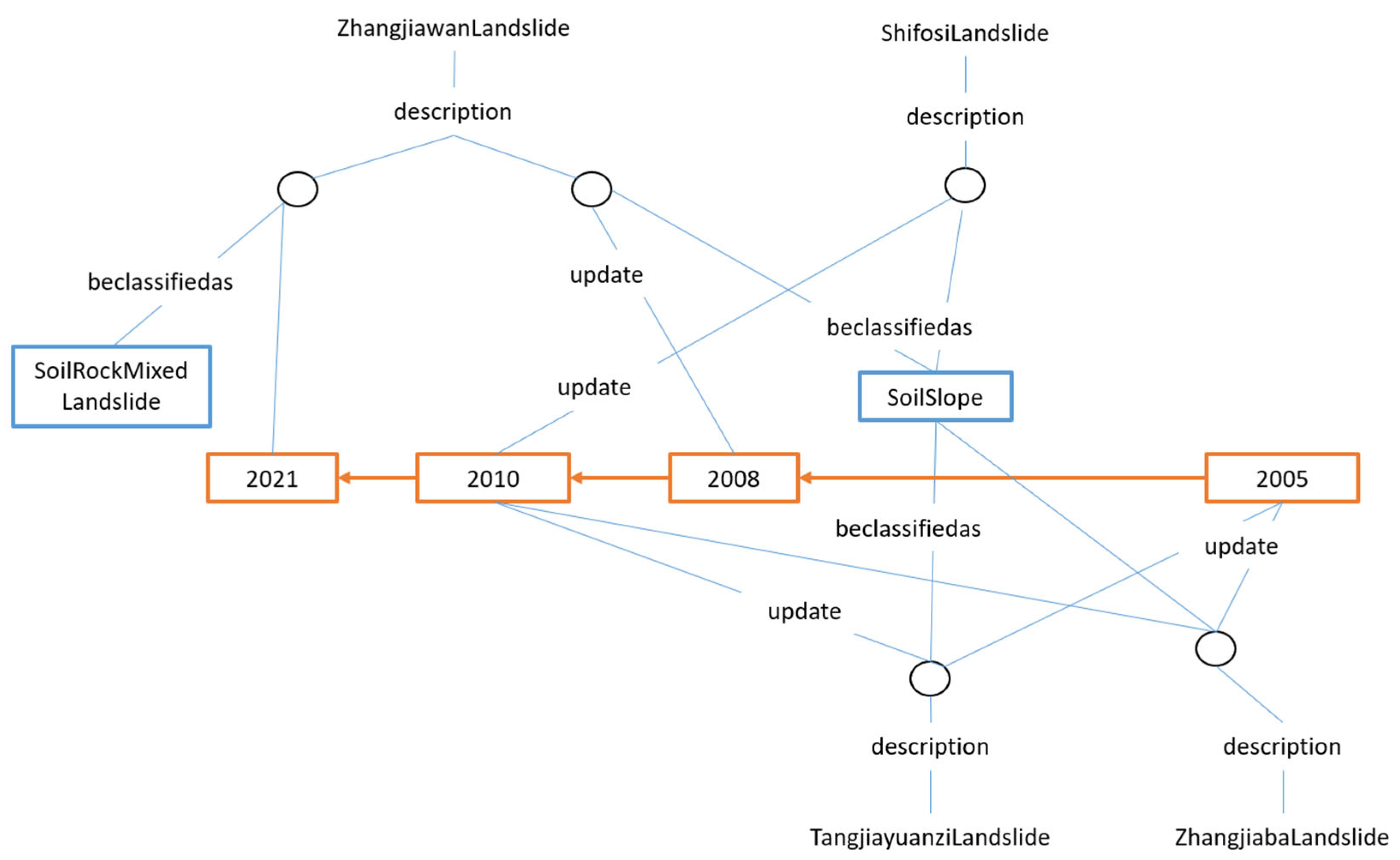
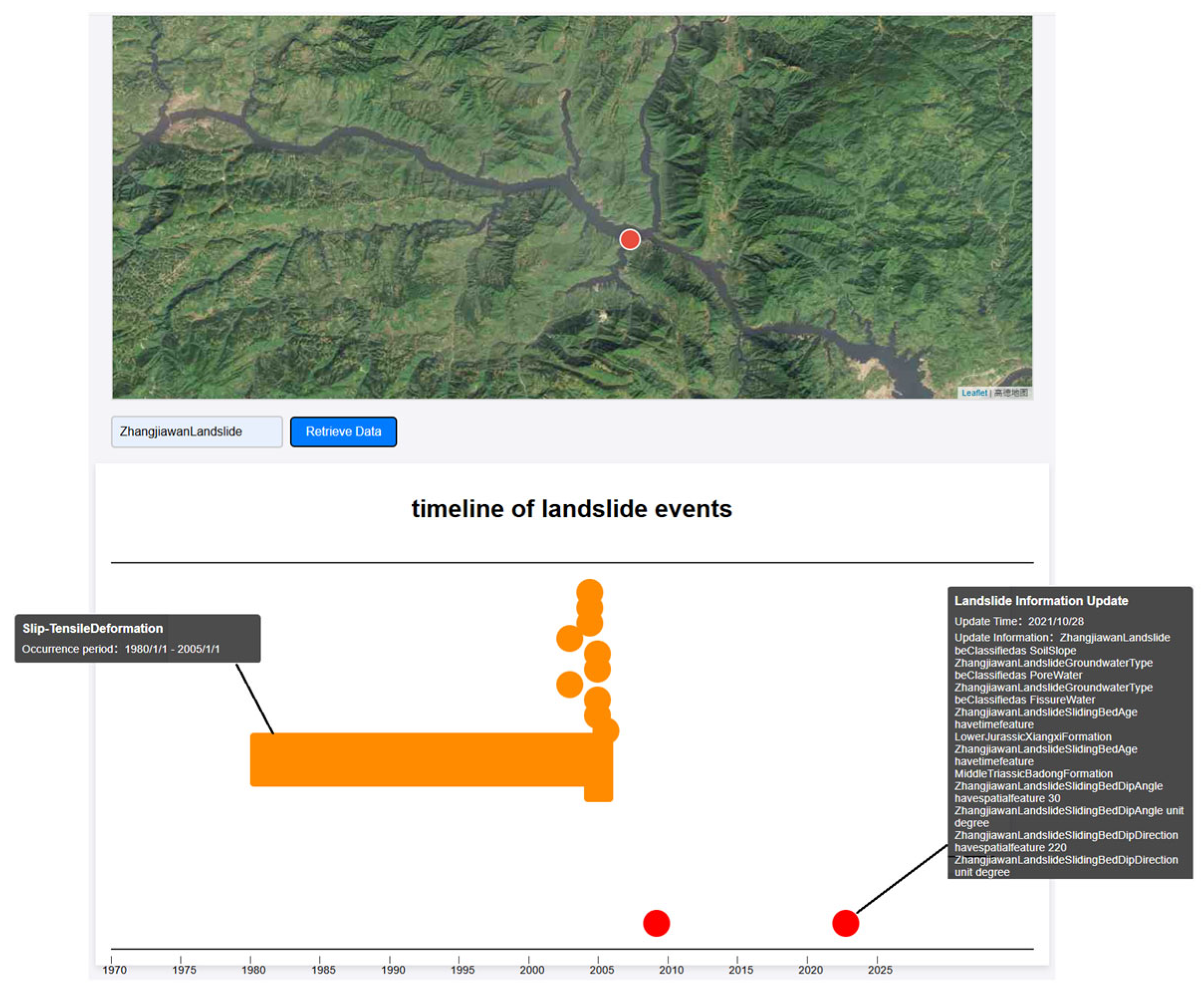
| Primary Label (Annotation Tag) | Secondary Label | |
|---|---|---|
| Basic Characteristics of Landslides | Geographical Entities | Landslide, sliding mass, sliding bed, sliding surface, sliding zone soil, and controlling structural plane |
| Landslide Classification | ||
| Geographical Location | ||
| Morphological Characteristics | Inclination and dip of sliding bed (controlling structural plane and sliding surface) | |
| Original slope height and gradient | ||
| Planar (profile) shape of the landslide | ||
| Scale Characteristics | Length, width, and thickness of the landslide | |
| Slope gradient and orientation of the landslide | ||
| Area and volume of the landslide | ||
| Elevation of the slope toe and crest | ||
| Depth and thickness of the sliding surface | ||
| Properties of Landslide Elements | Type of controlling structural plane | |
| Lithology and structure of sliding mass | ||
| Lithology and era of the sliding bed | ||
| Morphology of the sliding surface | ||
| Characteristics of sliding zone soil | ||
| Overview of Geological Environment | Topography and Landform | |
| Stratigraphy | Stratigraphic era | |
| Stratigraphic lithology | ||
| Inclination and dip of strata | ||
| Structure and Seismic Activity | Structural position | |
| Seismic intensity | ||
| Hydrogeology | Type of groundwater | |
| Groundwater depth | ||
| Groundwater recharge type | ||
| Annual average rainfall, maximum daily (hourly) rainfall, and flood (drought) water levels | ||
| Human Engineering and Activities | Type of activity | |
| Time of activity | ||
| Landslide-related Events | Community Monitoring and Prevention Events | Signs of deformation |
| Deformation time | ||
| Disaster Events | Landslide time | |
| Disaster level | ||
| Signs of deformation | ||
| Triggering factors | ||
| Adverse Reservoir Water Level Changes and Rainfall Events | Water level changes and rainfall | |
| Change time and rainfall time | ||
| Mitigation Engineering Events | Mitigation measures | |
| Time of mitigation |
| Indicator | Static Knowledge Graph | Multi-Temporal Knowledge Graph (MTKG) |
|---|---|---|
| Support for temporal queries | Unable to query time | Supports temporal queries (e.g., SPARQL directly filters the sx:update temporal attribute) |
| Temporal reasoning capability | Unable to infer temporal causality (e.g., cannot determine the temporal dependency of “rainfall → landslide”) | Can infer “event precedence and evolution chains” through the temporal ontology (e.g., deducing “landslide deformation the day after rainfall”) |
| Historical temporal rewind capability | Unable to rewind historical states (e.g., cannot query “2020 landslide evolution snapshot”) | Supports “temporal slicing” queries, enabling the retrieval of the graph’s state at any historical time point |
| Feature evolution tracking capability | Unable to track feature changes over time | Can query the evolution trajectories of features over any time interval, supporting multi-dimensional feature (geomorphology, landslide events, etc.) temporal correlation analysis |
Disclaimer/Publisher’s Note: The statements, opinions and data contained in all publications are solely those of the individual author(s) and contributor(s) and not of MDPI and/or the editor(s). MDPI and/or the editor(s) disclaim responsibility for any injury to people or property resulting from any ideas, methods, instructions or products referred to in the content. |
© 2025 by the authors. Licensee MDPI, Basel, Switzerland. This article is an open access article distributed under the terms and conditions of the Creative Commons Attribution (CC BY) license (https://creativecommons.org/licenses/by/4.0/).
Share and Cite
Wu, R.; Huang, M.; Ma, H.; Huang, J.; Li, Z.; Mei, H.; Wang, C. A Multi-Temporal Knowledge Graph Framework for Landslide Monitoring and Hazard Assessment. GeoHazards 2025, 6, 39. https://doi.org/10.3390/geohazards6030039
Wu R, Huang M, Ma H, Huang J, Li Z, Mei H, Wang C. A Multi-Temporal Knowledge Graph Framework for Landslide Monitoring and Hazard Assessment. GeoHazards. 2025; 6(3):39. https://doi.org/10.3390/geohazards6030039
Chicago/Turabian StyleWu, Runze, Min Huang, Haishan Ma, Jicai Huang, Zhenhua Li, Hongbo Mei, and Chengbin Wang. 2025. "A Multi-Temporal Knowledge Graph Framework for Landslide Monitoring and Hazard Assessment" GeoHazards 6, no. 3: 39. https://doi.org/10.3390/geohazards6030039
APA StyleWu, R., Huang, M., Ma, H., Huang, J., Li, Z., Mei, H., & Wang, C. (2025). A Multi-Temporal Knowledge Graph Framework for Landslide Monitoring and Hazard Assessment. GeoHazards, 6(3), 39. https://doi.org/10.3390/geohazards6030039








